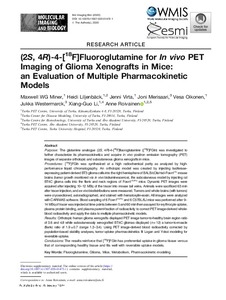(2S, 4R)-4-[18F]Fluoroglutamine for In vivo PET Imaging of Glioma Xenografts in Mice: an Evaluation of Multiple Pharmacokinetic Models
Maxwell WG Miner; Heidi Liljenbäck; Jenni Virta; Joni Merisaari; Vesa Oikonen; Jukka Westermarck; Xiang-Guo Li; Anne Roivainen
https://urn.fi/URN:NBN:fi-fe2021042826495
Tiivistelmä
Purpose: The glutamine analogue (2S, 4R)-4-[18F]fluoroglutamine ([18F]FGln) was investigated to
further characterize its pharmacokinetics and acquire in vivo positron emission tomography (PET)
images of separate orthotopic and subcutaneous glioma xenografts in mice.
Procedures: [18F]FGln was synthesized at a high radiochemical purity as analyzed by high-performance
liquid chromatography. An orthotopic model was created by injecting luciferase-expressing
patient-derived BT3 glioma cells into the right hemisphere of BALB/cOlaHsd-Foxn1nu mouse
brains (tumor growth monitored via in vivo bioluminescence), the subcutaneous model by injecting rat
BT4C glioma cells into the flank and neck regions of Foxn1nu/nu mice. Dynamic PET images were
acquired after injecting 10–12 MBq of the tracer into mouse tail veins. Animals were sacrificed 63 min
after tracer injection, and ex vivo biodistributions were measured. Tumors and whole brains (with tumors)
were cryosectioned, autoradiographed, and stained with hematoxylin-eosin. All images were analyzed
with CARIMAS software. Blood sampling of 6 Foxn1nu/nu and 6 C57BL/6J mice was performed after 9–
14 MBq of tracer was injected at time points between 5 and 60 min then assayed for erythrocyte uptake,
plasma protein binding, and plasma parent-fraction of radioactivity to correct PET image-derived whole-blood
radioactivity and apply the data to multiple pharmacokinetic models.
Results: Orthotopic human glioma xenografts displayed PET image tumor-to-healthy brain region ratio
of 3.6 and 4.8 while subcutaneously xenografted BT4C gliomas displayed (n = 12) a tumor-to-muscle
(flank) ratio of 1.9 ± 0.7 (range 1.3–3.4). Using PET image-derived blood radioactivity corrected by
population-based stability analyses, tumor uptake pharmacokinetics fit Logan and Yokoi modeling for
reversible uptake.
Conclusions: The results reinforce that [18F]FGln has preferential uptake in glioma tissue versus
that of corresponding healthy tissue and fits well with reversible uptake models.
Kokoelmat
- Rinnakkaistallenteet [27094]
